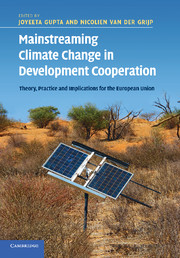Refine listing
Actions for selected content:
2285 results in Ebooks in ecology and environment
Index
-
- Book:
- Climate Policy Foundations
- Published online:
- 01 June 2011
- Print publication:
- 17 January 2011, pp 241-243
-
- Chapter
- Export citation
Frontmatter
-
- Book:
- Climate Policy Foundations
- Published online:
- 01 June 2011
- Print publication:
- 17 January 2011, pp i-vi
-
- Chapter
- Export citation
11 - The Outlook for Climate Policies
-
- Book:
- Climate Policy Foundations
- Published online:
- 01 June 2011
- Print publication:
- 17 January 2011, pp 206-224
-
- Chapter
- Export citation
5 - Forecasts of GHG Emissions and Global Temperatures
-
- Book:
- Climate Policy Foundations
- Published online:
- 01 June 2011
- Print publication:
- 17 January 2011, pp 82-95
-
- Chapter
- Export citation
4 - Emitting Economic Sectors
-
- Book:
- Climate Policy Foundations
- Published online:
- 01 June 2011
- Print publication:
- 17 January 2011, pp 64-81
-
- Chapter
- Export citation
Contents
-
- Book:
- Climate Policy Foundations
- Published online:
- 01 June 2011
- Print publication:
- 17 January 2011, pp vii-vii
-
- Chapter
- Export citation
6 - Potential Impacts of Climate Change
-
- Book:
- Climate Policy Foundations
- Published online:
- 01 June 2011
- Print publication:
- 17 January 2011, pp 96-110
-
- Chapter
- Export citation
PART ONE - EARTH'S CLIMATE HISTORY AND OUTLOOK
-
- Book:
- Climate Policy Foundations
- Published online:
- 01 June 2011
- Print publication:
- 17 January 2011, pp 9-10
-
- Chapter
- Export citation

Mainstreaming Climate Change in Development Cooperation
- Theory, Practice and Implications for the European Union
-
- Published online:
- 07 May 2010
- Print publication:
- 29 April 2010
Frontmatter
-
- Book:
- A Global Green New Deal
- Published online:
- 05 June 2012
- Print publication:
- 06 May 2010, pp i-vi
-
- Chapter
- Export citation
7 - Facilitating access to finance
-
- Book:
- A Global Green New Deal
- Published online:
- 05 June 2012
- Print publication:
- 06 May 2010, pp 190-200
-
- Chapter
- Export citation
Part IV - Towards a Greener World Economy
-
- Book:
- A Global Green New Deal
- Published online:
- 05 June 2012
- Print publication:
- 06 May 2010, pp 211-213
-
- Chapter
- Export citation
Index
-
- Book:
- A Global Green New Deal
- Published online:
- 05 June 2012
- Print publication:
- 06 May 2010, pp 297-308
-
- Chapter
- Export citation
List of figures
-
- Book:
- A Global Green New Deal
- Published online:
- 05 June 2012
- Print publication:
- 06 May 2010, pp ix-ix
-
- Chapter
- Export citation
Appendix 2 - Pew comparative analysis of clean energy jobs and investments in the United States, 1998–2007
-
- Book:
- A Global Green New Deal
- Published online:
- 05 June 2012
- Print publication:
- 06 May 2010, pp 287-292
-
- Chapter
- Export citation
10 - Summary of recommendations
-
- Book:
- A Global Green New Deal
- Published online:
- 05 June 2012
- Print publication:
- 06 May 2010, pp 214-216
-
- Chapter
- Export citation
4 - Challenges facing developing economies
-
- Book:
- A Global Green New Deal
- Published online:
- 05 June 2012
- Print publication:
- 06 May 2010, pp 159-168
-
- Chapter
- Export citation
Part III - The Role of the International Community
-
- Book:
- A Global Green New Deal
- Published online:
- 05 June 2012
- Print publication:
- 06 May 2010, pp 179-181
-
- Chapter
- Export citation
1 - Introduction: opportunity from crisis
-
- Book:
- A Global Green New Deal
- Published online:
- 05 June 2012
- Print publication:
- 06 May 2010, pp 3-30
-
- Chapter
- Export citation
3 - Reducing ecological scarcity
-
- Book:
- A Global Green New Deal
- Published online:
- 05 June 2012
- Print publication:
- 06 May 2010, pp 97-158
-
- Chapter
- Export citation
